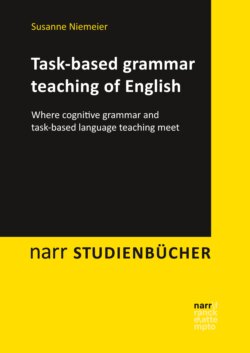Читать книгу Task-based grammar teaching of English - Susanne Niemeier - Страница 28
На сайте Литреса книга снята с продажи.
3.2.1 The centrality of meaning
ОглавлениеThe research field of cognitive grammar was introduced and developed by LANGACKER, who sees grammar as consisting of symbolic relationships, i.e., form-meaning pairings: “lexicon, morphology and syntax form a continuum of symbolic units serving to structure conceptual content for expressive purposes” (LANGACKER 1987: 35). A symbolic unit consists of the pairing of a semantic structure and a phonological structure. The primary function of language being communication, language – including its grammar – is all about meaning. As mentioned before, linguistic meaning is not seen “as referential and objective, but as subjective, dynamic, flexible, encyclopaedic and usage-based” (NIEMEIER 2013: 14). LANGACKER stresses the centrality of meaning in cognitive grammar as well when he comments in a somewhat funny way:
If generative linguistics views syntax as being central to language, Cognitive Linguistics accords this honor to meaning. The latter seems far more natural from the perspective of language users. When ordinary people speak and listen, it is not for the sheer pleasure of manipulating syntactic form – their concern is with the meanings expressed. This does not of course imply that grammar is unimportant in language or in language teaching. It is, however, helpful to realize that grammar subserves meaning rather than being an end in itself. (LANGACKER 2008: 67)
Cognitive grammar aims at accounting for all grammatical phenomena by not putting forward arguments about rules and exceptions to these rules but by investigating prototypical usages of a specific grammatical phenomenon as well as its more marginal, but still explainable usages. Compared to other grammatical approaches, this involves a change of perspective for teachers as well as for learners, as cognitive grammar does “not posit a clear borderline between rules and exceptions” but instead refers “to language phenomena as situated within a radial network of meaning with more prototypical instances at the core and more marginal instances on the fringes, all of them related and explainable” (NIEMEIER 2013: 15). Therefore, exceptions to the rule do not have to be learnt by heart anymore but the meaningfulness of marginal category exemplars can be reconstructed via their connection to the prototype. The marginal uses are not seen as arbitrary exceptions but instead as motivated, and therefore as explainable.
Most importantly, from the perspective of cognitive grammar, grammar is meaningful. WIERZBICKA sums up this perspective by stating that
… grammar is not semantically arbitrary. On the contrary, grammatical distinctions are motivated (in the synchronic sense) by semantic considerations, every grammatical construction is a vehicle of a certain semantic structure; and this is its raison d’être, and the criterion for determining its range of use. (WIERZBICKA 1988: 3)
This is why the focus of cognitive grammar is on the motivated, meaningful connections between forms, which are often ignored by other theories of language. Native speakers of a language are presumably not aware of such abstract grammatical meaning, as they use language in a quasi-automatised way. For learners of this language, the situation is somewhat different. They have automatised their own L1, and frequently transfer its grammatical tools to the new language, which in many cases does not work, as different language systems have generally developed different ways of expressing meaning. The further the two languages are typologically apart from each other, the fewer commonalities can be found. However, even in such typologically reasonably closely related languages as German and English the multitude of differences in conceptualization presents quite a challenge for language learners.
